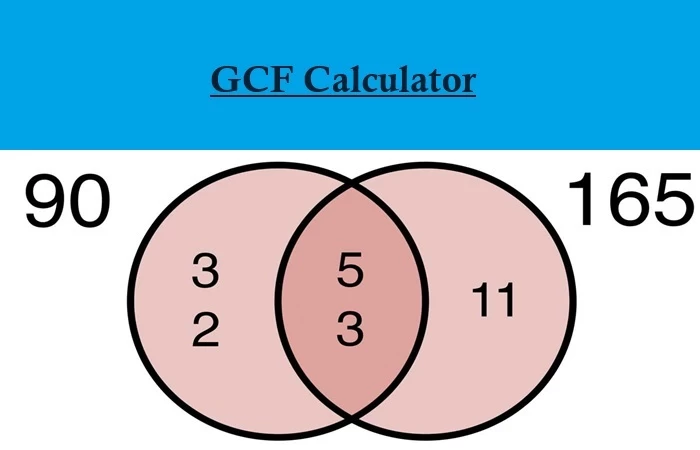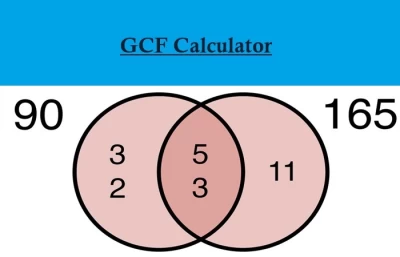Unveiling Mathematical Harmony – The GCF Calculator and Its Real-World Impact
Explore the world of numbers with our insightful content on the Greatest Common Factor (GCF) and its revolutionary digital counterpart; the GCF Calculator.

In our contemporary world, challenges and complexities in the form of equations and problems are as abundant as stars in the night sky. Mathematics, serving as the universal language of logic and precision, possesses a fascinating ability to unravel seemingly insurmountable problems. Among the significant entities in the realm of numbers stands the Greatest Common Factor (GCF), a concept unveiling shared secrets among multiple numbers.
Amidst the ever-evolving landscape of education and research, the relentless pursuit of efficient problem-solving tools remains paramount. Introducing the GCF Calculator, a digital marvel that simplifies the intricacies of identifying common ground among numbers, rendering it an indispensable asset for educators, researchers, and enthusiasts alike.
GCF
At the core of number theory lies the Greatest Common Factor (GCF), which represents the most significant number dividing two or more integers without leaving a remainder. It’s akin to discovering the most significant cake slice that can be evenly distributed among friends. Take, for instance, the numbers 18 and 24. To ascertain their GCF, common factors such as 1, 2, 3, and 6 are identified, with 6 emerging as the largest, and thus, the GCF of 18 and 24. Analogously, envision having 18 apples and 24 oranges and desiring to distribute them equally among friends – the GCF indicates the maximum number of fruits for equitable distribution, in this case, 6 fruits each.
GCF Calculator
In the swift realm of education and research, where time is of the essence, the GCF calculator emerges as a digital marvel expediting the process of determining the Greatest Common Factor. No more laborious manual calculations; a few clicks on the calculator reveal the shared secret among numbers, conserving precious time and cognitive resources.
Let’s exemplify this with 16 and 24. Input these numbers into the GCF Calculator; and presto! The result is 8, corroborating our manual calculation. This tool not only streamlines the process but also heightens accuracy, a crucial factor in mathematical pursuits. Additionally, don’t overlook its counterpart – the Least Common Multiple (LCM) calculator. While the GCF focuses on shared factors, the LCM Calculator identifies the smallest multiple common to two or more numbers. Together, they constitute a dynamic duo, adeptly addressing mathematical challenges. If you’re interested in exploring additional calculators, check out CoolCalculator for a variety of useful tools.
Real-Life Applications of the GCF Calculator
- For a biologist studying population dynamics, the GCF aids in determining optimal breeding conditions by identifying common factors influencing population growth.
-
Cryptographers utilize the GCF to bolster the security of algorithms, playing a pivotal role in number theory, the foundation of many cryptographic systems.
-
Researchers across disciplines rely on mathematical tools for statistical analysis and data interpretation, with the GCF simplifying complex relationships among variables for meaningful insights.
-
In various real-world scenarios, from resource allocation in economics to streamlining manufacturing processes in engineering or orchestrating schedules in project management, the GCF Calculator proves its versatility as a problem-solving companion.
-
Imagine having a certain number of candies and wanting to share them among friends – the GCF helps determine the largest number of candies for equal distribution.
-
When dealing with fractions like 4/8, the GCF simplifies the fraction by identifying the largest number and dividing both the numerator and denominator.
-
Everyday ratios, such as 6 boys to 8 girls, can be simplified using the GCF, facilitating a clearer understanding.

In our contemporary world, challenges and complexities in the form of equations and problems are as abundant as stars in the night sky. Mathematics, serving as the universal language of logic and precision, possesses a fascinating ability to unravel seemingly insurmountable problems. Among the significant entities in the realm of numbers stands the Greatest Common Factor (GCF), a concept unveiling shared secrets among multiple numbers.
Amidst the ever-evolving landscape of education and research, the relentless pursuit of efficient problem-solving tools remains paramount. Introducing the GCF Calculator, a digital marvel that simplifies the intricacies of identifying common ground among numbers, rendering it an indispensable asset for educators, researchers, and enthusiasts alike.
GCF
At the core of number theory lies the Greatest Common Factor (GCF), which represents the most significant number dividing two or more integers without leaving a remainder. It’s akin to discovering the most significant cake slice that can be evenly distributed among friends. Take, for instance, the numbers 18 and 24. To ascertain their GCF, common factors such as 1, 2, 3, and 6 are identified, with 6 emerging as the largest, and thus, the GCF of 18 and 24. Analogously, envision having 18 apples and 24 oranges and desiring to distribute them equally among friends – the GCF indicates the maximum number of fruits for equitable distribution, in this case, 6 fruits each.
GCF Calculator
In the swift realm of education and research, where time is of the essence, the GCF calculator emerges as a digital marvel expediting the process of determining the Greatest Common Factor. No more laborious manual calculations; a few clicks on the calculator reveal the shared secret among numbers, conserving precious time and cognitive resources.
Let’s exemplify this with 16 and 24. Input these numbers into the GCF Calculator; and presto! The result is 8, corroborating our manual calculation. This tool not only streamlines the process but also heightens accuracy, a crucial factor in mathematical pursuits. Additionally, don’t overlook its counterpart – the Least Common Multiple (LCM) calculator. While the GCF focuses on shared factors, the LCM Calculator identifies the smallest multiple common to two or more numbers. Together, they constitute a dynamic duo, adeptly addressing mathematical challenges. If you’re interested in exploring additional calculators, check out CoolCalculator for a variety of useful tools.
Real-Life Applications of the GCF Calculator
- For a biologist studying population dynamics, the GCF aids in determining optimal breeding conditions by identifying common factors influencing population growth.
-
Cryptographers utilize the GCF to bolster the security of algorithms, playing a pivotal role in number theory, the foundation of many cryptographic systems.
-
Researchers across disciplines rely on mathematical tools for statistical analysis and data interpretation, with the GCF simplifying complex relationships among variables for meaningful insights.
-
In various real-world scenarios, from resource allocation in economics to streamlining manufacturing processes in engineering or orchestrating schedules in project management, the GCF Calculator proves its versatility as a problem-solving companion.
-
Imagine having a certain number of candies and wanting to share them among friends – the GCF helps determine the largest number of candies for equal distribution.
-
When dealing with fractions like 4/8, the GCF simplifies the fraction by identifying the largest number and dividing both the numerator and denominator.
-
Everyday ratios, such as 6 boys to 8 girls, can be simplified using the GCF, facilitating a clearer understanding.
Conversation
Latest Blogs
© Blog CoolCalculator, Explore CoolCalculator, your destination for the latest insights, tips, and updates on the world of online calculators. Stay informed and make your calculations smarter with our blog. ,
Designed
by Saad Media Team , Team Lead M.Rizwan Akhtar












